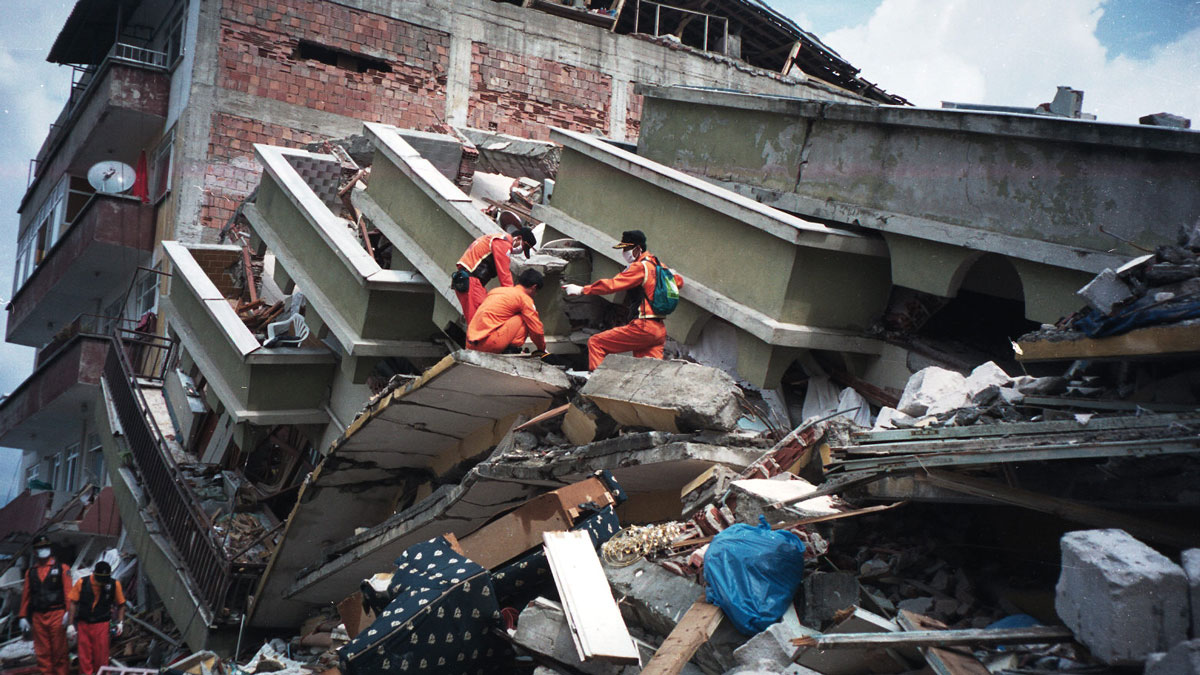A translation of this article was made possible by a partnership with Planeteando. Una traducción de este artículo fue posible gracias a una asociación con Planeteando.
Residents of Izmit, Turkey, were sleeping when the ground started shaking on 17 August 1999. The temblor registered a magnitude of 7.4, triggered aftershocks, and proved utterly devastating, leaving more than 17,000 dead, tens of thousands injured, and billions of dollars in damages. But it was extraordinary for another reason: It affected the movement of a tectonic plate. The finding could cause a rethinking of how quake risk models are put together.
Scientists have long known that earthquakes happen when slips occur along fault lines. These can be generated by stress on the edges of tectonic plates, which are in constant motion over Earth’s mantle. But researchers investigating the Izmit quake have made unprecedented observations of plate motion and concluded that earthquakes themselves can affect plate movement, which could, in turn, affect subsequent earthquakes. “These results suggest the existence of a whole-plate kinematic signal associated with the stress released by large earthquakes,” they wrote in a Geophysical Journal International study.
GPS Data Reveal Motion Change
The theory of plate tectonics, generally accepted from the middle of the 20th century, assumes that large earthquakes don’t perturb plate motion; instead, the motion is the result of a transfer of energy via stress built up over long periods of time. The researchers reasoned that although this one-way relationship is the case for large plates, microplates may be more susceptible to influence from quakes because of their reduced area covering the boundary between the lithosphere and the asthenosphere.
The Anatolian microplate offered a good opportunity to test this idea, not only because it’s small, stretching across most of Turkey and moving toward the Mediterranean Sea, but also because it underpins a region that has had good GPS data coverage for decades. GPS data are used in geodetic surveys, which analyze points on Earth’s surface, including how they are affected by quakes. Comparing data over time can reveal plate motion.
“Earthquakes and plate motions are linked in a feedback mechanism, which means that large seismic events are capable of altering the rigid motion of plates.”
The researchers calculated that the rotational force, or torque, required to change the tectonic plate’s trajectory was very close to the torque released by the earthquakes. In an analysis of the GPS data, they found that not only did the Anatolian microplate change direction but also the frequency of quakes around Turkey was also altered after the Izmit quake.
“In our study, we observe a change in the Anatolian kinematics from before to after the Izmit earthquake, and we discover that the force change needed to change the Anatolian motion to the degree determined by the geodetic observations is in agreement with the force change imparted by the Izmit earthquake,” said coauthor Juan Martin de Blas, a geology postdoctoral researcher at the University of Copenhagen.
“Earthquakes are not only the product of plate motions,” he added. “Instead, earthquakes and plate motions are linked in a feedback mechanism, which means that large seismic events are capable of altering the rigid motion of plates. This link has further implications since it implies that plate motions may vary also in the years to decades before an earthquake occurs.”
A Slew of New Questions
This feedback mechanism could represent a major new insight into plate tectonics. The challenge of one of the central tenets of tectonics—that plate motions are basically steady through the quake cycle—met some resistance during the study’s review process. However, de Blas said, the team found open-minded reviewers who made suggestions that helped strengthen the paper.
The researchers believe the insight should be incorporated into computer models used to calculate earthquake risk. Instead of assuming that plate motions are constant, a feedback mechanism between quakes and plates should be taken into account, they argue. This calculation also includes greater use of data from GPS devices located away from plate edges to give a better overall picture of plate dynamics, according to the team.
“Though scientists have suspected that plate velocities may vary somewhat over decades to millennia, this variation has not previously been documented as clearly as it has in this study for plates as large as the Anatolian plate,” said Richard Styron, an active faults specialist with Italy-based earthquake risk foundation Global Earthquake Model who was not involved in the study. “Future research will be required to better understand the mechanics of this change, in particular the response of the viscoelastic lower crust and upper mantle that modulate plate motions and the tempo of the earthquake cycle.”
Other unknowns include whether the plate motion change is permanent, connected to a larger evolution of regional tectonics, or a transient change that will be reversed, said Styron, who hailed the work as “a remarkable study.”
Meanwhile, de Blas and colleagues are planning to investigate other areas for evidence of the feedback mechanism. They are searching for geologic settings where similar dynamics apply and will test whether the feedback mechanism also applies to the interseismic period, when energy builds up before being suddenly released through earthquakes.
—Tim Hornyak (@robotopia), Science Writer

